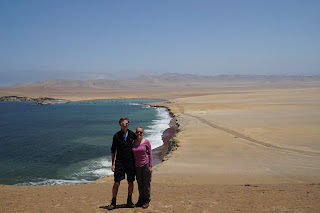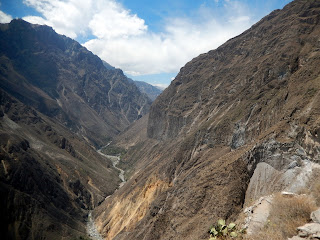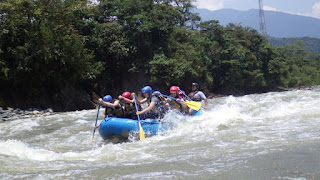We arrived in the capital Lima after an epic 36 hour bus journey! The extra cost to upgrade to VIP seats was well worth it. More legroom, wider seats and a personal TV like being on a plane. We stayed in the upmarket and trendy district of Miraflores, which could fairly easily fit into any European or US city. During our 2 day stay we visited a pre-Incan Huaca (temple), explored downtown Lima on a walking tour and cycled along the cliff tops of Miraflores. On our second night we treated ourselves to some gourmet Peruvian food and ate at the Panchita restaurant.
The following day was Ben's birthday and we decided to do something a bit different and celebrate by spending half the day on another bus! We had booked to travel from Lima to Cusco with Peruhop. This is a hop-on hop-off tourist bus that runs in the south of Peru (and connects to Bolivia). Whilst a bit more pricey than the standard long distance buses, they make stops at places that are otherwise harder to get to, include some tours in the price, have an English speaking guide and provide an opportunity to meet other travellers. Our first brief stop was on the outskirts of Lima at a memorial to those who died in the Pacific War between Peru and Chile at the end of the 19th Century. Here we learnt some history and got our first taste of the rivalry that still exists today between Peru and Chile. Mid-afternoon we arrived in the beach town of Paracas. The hostel here backed onto the beach and had a great terrace with a pool, pool table, table tennis and a bar. The perfect place for a birthday cocktail! We spent quite a bit of time just relaxing in the nice surroundings. Whilst in Paracas we also went sea kayaking and took a boat trip to Las Islas Ballestas where we saw thousands of seabirds including a couple of penguins. Due to the huge number of birds there is also a lot of guano (bird poo) which is harvested for use as fertiliser every 7 years.
Our next stop was the desert oasis of Huacachina. This is a tiny village surrounding an oasis and only really exists now to cater for tourists both international and Peruvian. There isn't much to do here so we only spent 2 night, but the highlight was a dune buggy trip into the desert. The only word to describe this experience is crazy! The buggy was basically a huge engine, some steel tube fashioned into a chassis / roll cage, some seats and 4 huge wheels. It was like being on a roller coaster but with no track to make sure you stay in the right place. Our driver clearly had done this hundreds of times before and was very relaxed throughout the whole trip (the rest of us were slightly less so). We also had a short go at sand-boarding down some of the dunes. We tried to stand up on the shorter ones and used them as sledges for the huge steep ones.
In nearby city of Ica we visited the regional museum to find out more about the pre-colonial history of the area. Amongst lots of pottery and textiles they had several mummies and human skulls on display. The skulls had evidence of trepanning, which is where holes were cut in the skull (whilst the patient/victim was still alive) in order to let bad spirits out or allow better communication with the spirit world. It was very interesting, if a little creepy seeing so many human skulls. We also visited a Pisco winery before leaving the area. Pisco (distilled wine) is the national drink and a source of much pride for all Peruvians. It is often combined with egg white and lemon juice to make the famous Pisco Sour cocktail. Pisco is also the source of yet more rivalry with Chile, as both claim ownership of the drink and say that the other nation's drink isn't 'real' Pisco.
Hopping back on to the bus again we drove to Nasca - home of the famous Nasca lines. These are images carved into the earth by ancient civilisations. No-one really knows what they are for, most probably some sort of calendar, but with the largest being over 100m long there is no way they would have been able to appreciate their efforts (unless they invented flight and then kept it a secret!). As it is so hot and dry the weather doesn't seem to have affected them so they lay undiscovered for hundreds of years. They are so hard to spot from ground level that when building the Panamerican Highway in the area they built the road right through the middle of the lizard! We didn't think our stomachs would be strong enough to cope with a tiny aeroplane zipping over them, so settled for a tall look out tower where we could see a small section. Even this tiny glimpse was impressive, and so mystifying!
The next 'hop-off' point was in Arequipa. A pretty town with a backdrop of volcanoes situated in the foothills of the Andes at 2300m above sea level. Here we began what would be almost a month at high altitude with Arequipa being the lowest point! From here we set off for a 3 day trek into the Colca Canyon. The Colca Canyon is the second deepest in the world, being twice as deep as the Grand Canyon in the USA. The measuring and defining of canyons is not exactly agreed upon worldwide so the second deepest claim may not be verified internationally. Nonetheless a trek down to the bottom, along part of it and back up to the rim was to be no mean feat and would serve as good practice for our upcoming Inca Trail trek. Day 1 started at 3am with a 5hr drive to the canyon, but we were rewarded with amazing views from the edge on arrival. We even got to see several condors effortlessly gliding over the canyon. The trek on the first day was almost entirely downhill into the canyon, but still hard work due to the intense heat. Needless to stay the views were stunning for the whole trek and words here can't really do them justice.
Day 2 began at the more leisurely time of 7am after a breakfast of pancakes. We walked along the canyon passing through a couple of small villages stopping occasionally for our guide to explain various things to us. We learnt about the culture and traditions of the local Quechua people, and interesting facts about the flora and fauna.
Our accommodation for the second night was in a small oasis where we had tasty food and went for a much needed swim in a pool filled with water from a mountain spring. Cold, but refreshing.
The cliffs of Miraflores
Islas Ballestas boat trip
In the Paracas National Reserve
Our next stop was the desert oasis of Huacachina. This is a tiny village surrounding an oasis and only really exists now to cater for tourists both international and Peruvian. There isn't much to do here so we only spent 2 night, but the highlight was a dune buggy trip into the desert. The only word to describe this experience is crazy! The buggy was basically a huge engine, some steel tube fashioned into a chassis / roll cage, some seats and 4 huge wheels. It was like being on a roller coaster but with no track to make sure you stay in the right place. Our driver clearly had done this hundreds of times before and was very relaxed throughout the whole trip (the rest of us were slightly less so). We also had a short go at sand-boarding down some of the dunes. We tried to stand up on the shorter ones and used them as sledges for the huge steep ones.
'Driving' the dune buggy
In nearby city of Ica we visited the regional museum to find out more about the pre-colonial history of the area. Amongst lots of pottery and textiles they had several mummies and human skulls on display. The skulls had evidence of trepanning, which is where holes were cut in the skull (whilst the patient/victim was still alive) in order to let bad spirits out or allow better communication with the spirit world. It was very interesting, if a little creepy seeing so many human skulls. We also visited a Pisco winery before leaving the area. Pisco (distilled wine) is the national drink and a source of much pride for all Peruvians. It is often combined with egg white and lemon juice to make the famous Pisco Sour cocktail. Pisco is also the source of yet more rivalry with Chile, as both claim ownership of the drink and say that the other nation's drink isn't 'real' Pisco.
Hopping back on to the bus again we drove to Nasca - home of the famous Nasca lines. These are images carved into the earth by ancient civilisations. No-one really knows what they are for, most probably some sort of calendar, but with the largest being over 100m long there is no way they would have been able to appreciate their efforts (unless they invented flight and then kept it a secret!). As it is so hot and dry the weather doesn't seem to have affected them so they lay undiscovered for hundreds of years. They are so hard to spot from ground level that when building the Panamerican Highway in the area they built the road right through the middle of the lizard! We didn't think our stomachs would be strong enough to cope with a tiny aeroplane zipping over them, so settled for a tall look out tower where we could see a small section. Even this tiny glimpse was impressive, and so mystifying!
The next 'hop-off' point was in Arequipa. A pretty town with a backdrop of volcanoes situated in the foothills of the Andes at 2300m above sea level. Here we began what would be almost a month at high altitude with Arequipa being the lowest point! From here we set off for a 3 day trek into the Colca Canyon. The Colca Canyon is the second deepest in the world, being twice as deep as the Grand Canyon in the USA. The measuring and defining of canyons is not exactly agreed upon worldwide so the second deepest claim may not be verified internationally. Nonetheless a trek down to the bottom, along part of it and back up to the rim was to be no mean feat and would serve as good practice for our upcoming Inca Trail trek. Day 1 started at 3am with a 5hr drive to the canyon, but we were rewarded with amazing views from the edge on arrival. We even got to see several condors effortlessly gliding over the canyon. The trek on the first day was almost entirely downhill into the canyon, but still hard work due to the intense heat. Needless to stay the views were stunning for the whole trek and words here can't really do them justice.
A view of Colca Canyon from halfway down
Canyon supermarket selling the essentials of water and snacks
Our accommodation for the second night was in a small oasis where we had tasty food and went for a much needed swim in a pool filled with water from a mountain spring. Cold, but refreshing.
The second night was spent in basic thatched huts
The third and final day consisted of the uphill climb out of the canyon. This was the equivalent of climbing up Ben Nevis, but we were already twice as high when at the bottom! We started walking in the dark with head torches to light our way so that we would avoid hiking in the the mid-day heat. We kept the pace slow as we weren't fully used to the altitude yet and made it to the top in under 3hrs. Some of our group elected to use mules to get to the top and overtook us just before the top despite setting off over an hour later. On the drive back to Arequipa we stopped at some natural hot springs where we spent a relaxing hour. The water had to be mixed with cold water before anyone was allowed in as it was literally boiling as it came out the ground. It was very strange to see a spring of boiling water.
Victory banana!
After one night back in Arequipa we got back on the Peruhop bus for the journey through the Andes to the Inca capital of Cusco, where we would meet Fiona's sisters and our friend Gawaine for more adventures.
















